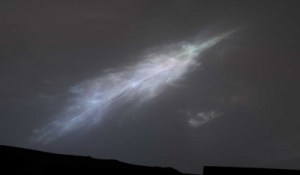NASA’s Curiosity captures first ‘Sun rays’ on Mars IANS Updated: March 7th, 2023, 14:20 IST in Sci-Tech 0 Share on Facebook Share on Twitter Share on WhatsApp Share on Linkedin Washington: NASA’s Curiosity rover has captured first-ever “sun rays” on Mars, the US space agency said. The rays were imaged as the Sun descended over the horizon February 2, with “rays of light illuminated a bank of clouds”. These are also known as crepuscular rays, from the Latin word for “twilight”.
“It was the first time sun rays have been so clearly viewed on Mars,” according to the mission officials. Curiosity captured the scene during the rover’s latest twilight cloud survey, which began in January and will wrap up in mid-March. It relies more often on the rover’s colour Mast Camera, or Mastcam, which helps scientists see how cloud particles grow over time.
In contrast, the previous cloud survey conducted in 2021 included more imaging by Curiosity’s black-and-white navigation cameras, providing a detailed look at a cloud’s structure as it moves. The survey also showed night-shining clouds. Most Martian clouds hover no more than 60 kilometres above the ground and are composed of water ice, but the clouds in the latest images appear to be at a higher altitude, where it’s especially cold.
That suggests these clouds are made of carbon dioxide ice, or dry ice. On Earth, clouds provide scientists with complex but crucial information for understanding the weather. By looking at when and where clouds form, scientists can learn more about the Martian atmosphere’s composition and temperatures, and the winds within it.
In addition to the image of sun rays, Curiosity captured a set of colourful clouds shaped like a feather January 27. When illuminated by sunlight, certain types of clouds can create a rainbow-like display called iridescence. This feather-shaped iridescent cloud was captured just after sunset January 27, 2023, the 3,724th Martian day, or sol, of Curiosity’s mission.
Studying the colours in iridescent clouds can tell scientists something about particle size within the clouds and how they grow over time. “Where we see iridescence, it means a cloud’s particle sizes are identical to their neighbours in each part of the cloud,” Mark Lemmon, an atmospheric scientist with the Space Science Institute in Boulder, Colorado said. “By looking at colour transitions, we’re seeing particle size changing across the cloud.
That tells us about the way the cloud is evolving and how its particles are changing size over time. ” Curiosity captured both the sun rays and iridescent clouds as panoramas, each of which was stitched together from 28 images sent to Earth. The images have been processed to emphasise the highlights.
Tags: Curiosity rover MARS Nasa Share Tweet Send Share Suggest A Correction Enter your email to get our daily news in your inbox. Leave this field empty if you’re human: Related Posts WhatsApp may soon let users set expiration date for groups on iOS beta March 7, 2023 WhatsApp to clearly outline how its privacy updates will affect EU users March 7, 2023 Twitter down for millions as only 1 engineer left handling crucial APIs March 7, 2023 No association between ranitidine and cancer risk, says recent study March 6, 2023 Airtel launches 5G Plus services in 125 cities March 6, 2023 63% of tech workers started their own firm post-layoff: Report March 6, 2023 Leave a Reply Cancel reply Your email address will not be published. Required fields are marked * Comment * Name * Email * Website Save my name, email, and website in this browser for the next time I comment.
Δ.
From: orissapost
URL: https://www.orissapost.com/nasas-curiosity-captures-first-sun-rays-on-mars/
